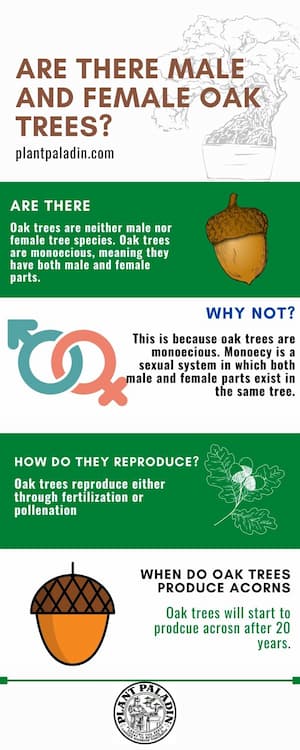This website is supported by its readers. If you click one of my links I may earn a commission. I am also a participant in the Amazon affiliates program and I will also earn a commission from qualified purchases.

Appearing about 65 million years ago, oak trees are one of the world’s oldest and most widespread trees. Not only are they majestic-looking, but they also produce oak wood, which is the most commonly used type of hardwood. This begs the question; are there male and female oak trees?
Oak trees are neither male nor female tree species. Oak trees are monoecious, meaning they have both male and female parts. Like many other tree species, oaks are wind-pollinated, releasing pollen grains in the air to reproduce.
In this article, I’ve put together the ultimate guide on oak tree reproductive organs, how they reproduce, and more!
Just a quick heads up, over the past three years of running Plantpaladin, hundreds of people have asked for product recommendations. As such, You can find my favorite indoor bonsai tree here (link takes you to Bonsaiboy), my favorite outdoor bonsai tree (link takes you to Bonsaiboy), or have a look at all the products I recommend here.
Are There Male and Female Oak Trees?
So recently, I’ve invested in growing an oak bonsai tree from an acorn. While I’m prepared for the challenge ahead, one question I’ve been asking myself is if oak trees are male or female.
Understanding this will determine how easy it is to reproduce and grow more oak trees, especially if the tree branches are too weak to clone.
As such, I got in touch with my local garden center, visited my local botanical gardens, and got in touch with five plant paladin readers to ask them if there are male and female oak trees.
To summarize:
- As mentioned earlier, there are no male or female oak trees.
- This is because oak trees are monoecious like many other tree species.
- Unlike diecious trees, which only have male or female reproductive organs, oak trees can reproduce from a single tree!
- Monoecy is a sexual system mainly found in seed plants, in which both male and female parts exist in the same tree.
The male part of the oak tree is located in the tree’s catkins.
The female reproductive system of oaks trees is found on the husks, where acorns are typically developed.
Let’s explore this in more detail:

Where Are the Male and Female Parts of Oak Trees Located?
One oak tree produces male blooms (Staminate) and female flowers (Pistillate).
Staminate and Pistillate grow on the same branch, usually in the form of a vivid green dangling catkin.
You can typically find the male blossoms on the catkins themselves and the female blooms on the husks, where the acorns develop.
How Do Oak Trees Reproduce?
Isn’t it incredible how a tiny little acorn can grow into a magnificent 100-foot-tall oak tree that produces even more acorns? Before this nearly decade-long process can even begin, oak trees must first mate!
The question is; how does a monoecious tree reproduce? To make matters simple, we can divide the reproduction process of an oak tree into two stages:
-
Pollination
-
Fertilization
Let’s look at each stage to learn how these guys reproduce!
Pollination
Have you ever taken a nice walk in the early spring and noticed a massive amount of yellowish spikes beneath your neighborhood oak tree? Well, these are male catkins that have just released their pollen into the air!
Let’s start from the beginning. In early spring, male blossoms form into these slender, wormlike shapes known as catkins.
These catkins contain stamens, which then produce pollen in the air. Once the pollen is produced, the entire catkin will fall from the tree, carpeting the ground in thousands of them!
Fertilization
During the fertilization stage, it’s safe to say that the calming spring breeze does play the role of cupid for oaks. Let’s elaborate on that; once the pollen grains are discharged into the air, the yellow mist follows the wind until it lands on the female flower.
As a result, the pollen fertilizes the female blossom, which later produces acorns and continues the life cycle of the oak.
How Many Acorns Become Oak Trees?
Unfortunately, only one in 10,000 acorns grows into an oak tree.
Squirrels and other wildlife consume most acorns before they get a chance to mature into trees.
However, you’d expect that squirrels snatching acorns would have a detrimental effect on oak regeneration. Quite the opposite!
According to research, squirrels play a significant role in spreading oak trees.
These adorable little guys plant their acorns in the ground and forget where they buried them.
As a result, they wind up planting a lot of oak trees by accident!
How Do Different Species of Oak Reproduce?
There are over 600 species of oak trees, with the following being the most common:
- White Oak
- Willow Oak
- Japanese Evergreen Oak
- Bur Oak
- Pin Oak
All oak tree species are monoecious and wind-pollinated. As a result, they use the pollination and fertilization methods we previously mentioned above.
However, what distinguishes oak species is their acorn production rate. Also, the time it takes for acorns to ripen differs from one oak species to another. For example, red oak acorns mature in two seasons, while white oak acorns mature in only one season.
When Do Oak Trees Begin Producing Acorns?
It takes at least 20 years for oaks to produce acorns. Additionally, it takes oak trees around 50 to 80 years to reach peak acorn production. After the age of 80, acorn production typically begins to decrease.
However, it still depends on the species of oak. For example, the White Oak tree starts producing thin white oak acorns at 20 years old and has a peak production at 50.
Another example is the Pin Oak tree, which produces round pin oak acorns at 20. The Bur Oak tree, on the other hand, starts producing its large acorns at age 35!
And even so, acorn production is only sometimes consistent every year. This is because several factors affect the production process, some of which include:
- Nutrition
- Excessively low or high temperatures
- Windy conditions
- Excessive rain
- Lighting
- Drought
How Many Acorns Does an Oak Tree Produce?
An average oak tree can produce up to 2,200 acorns each year and 10 million acorns throughout its lifetime. However, an oak tree can produce up to 10,000 acorns in a mast year.
Derived from the Old English term ‘maest,’ which means piled forest nuts on the ground, a mast year is a year in which trees produce a rich amount of seeds. It typically happens every 5-10 years.
Survey on whether there are male and female oak trees
As mentioned, I didn’t just want to rely on my research and got in touch with five plant paladin readers who own oak trees, asking them if they are male and female.
Here are the results:

Conclusion
In a nutshell (pun intended), there are no male or female oak trees because oaks are monoecious, meaning they carry both male and female reproductive organs.
A single oak tree can grow both male and female flowers, which mate in the early spring with the help of the gentle spring breeze. As a result, the female blossom produces acorns that carry the oak life cycle.
If you’re wondering if the oak tree down the street or in your backyard is a boy or a girl, rest assured, it’s both!
My top picks for the gear you will need!
So like I mentioned earlier, over the past three years of running PlantPaladin, hundreds of people have asked me for my recommendations on the best bonsai gear on the market.
Having spent thousands of dollars on bonsai items these past few years and tested at least 100 bonsai-specific products, I’ve listed my favorite products below – All of which I highly recommend and think you can get great value.
They can purchase directly by clicking the link to take them to Amazon.
Bonsai Tool Set: One of the significant challenges I’ve had is finding a toolset that was not only durable but didn’t break the bank. SOLIGT has recently developed a fantastic bonsai tool set that covers all the tools you need to trim, prune, and repot your trees. – You can grab it here.
Complete Bonsai Set: Many of you will want to grow your bonsai trees entirely from scratch, but finding the varicose seeds, pots, and other items in one place can be challenging. Leaves and Sole then have created a complete bonsai set that I’ve personally used that ticks all the boxes. You can grab it here.
Bonsai wire: The number of times I’ve run out of wire for my bonsai or purchased cheap bonsai wire that doesn’t do the job is embarrassing for me to admit. After a lot of trial and error, I found that using Hotop’s aluminum bonsai wire is one of the best options on the market. This can easily be used for both indoor and outdoor bonsai. You can grab it here.
This post was written by Fehed Nicass who has been passionate about bonsai for over 3 years. He currently resides in the UK and works in sales.
